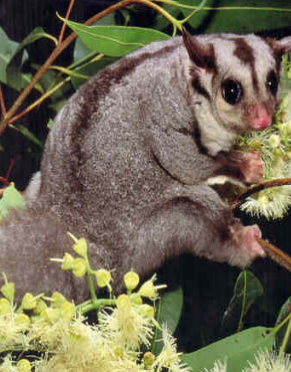Fun Facts About Squirrel Glider
Fun Facts About Squirrel Glider
Scientific name: Petaurus norfolcensis1. Other common names: Flying Squirrel, Sugar Squirrel, Squirrel Flying Phalanger.
2. The Squirrel Glider is a mediumsized (40-53cm) nocturnal, gliding possum. Blue-grey to brown-grey above, with a white belly and a black stripe that runs from between the eyes down its back. The Squirrel Glider has a long bushy tail which is sometimes black-tipped. Both sexes are similar in appearance.
3. The squirrel glider is not a squirrel at all. It actually is a member of the opossum family. When it senses danger, it jumps and moves in the direction of the thickest growth of trees around, trusting that there will be branches to grab onto for safe landing!
4. The Squirrel Glider is an arboreal (tree-dwelling) mammal of eastern Australia. Resting during the day in cup-shaped, leaf-lined nests in tree hollows, they emerge at night to forage in tree and understorey canopies almost never coming to the ground.
5. Key habitat requirements include; abundant tree hollows for refuge and nesting, areas with more than one eucalypt species and/or an understorey of wattles.
6. Squirrel Gliders principally feed on;
a. Invertebrates (beetles and their larvae, moths, caterpillars, cicadas and grasshoppers),
b. Sugary exudates from insects,
c. Sap, gum, pollen and nectar of eucalypts, wattles and/or banksias
d. Seeds and fruit
e. Small roosting birds, eggs and mice are occasionally eaten.
7. Squirrel Gliders have an area of loose skin connected from wrist to ankle. When they jump between trees, they extend this skin which allows them to glide.
8. Each female usually produces two young which remain in the pouch for about 70 days when they are deposited in a nest for about 40-50 days. At about three months old, the young leave the nest to forage.
9. The natural predators of Squirrel Gliders include birds (including owls and kookaburras) and reptiles.
10. Squirrel Gliders can glide for up to 90 m.
11. Squirrel Gliders are threatened by feral cats and foxes. The destruction of forests-especially tree hollows which they use for nests-has had a dramatic effect on Squirrel Glider populations.
12. When you first spot one of these cute, bushy tailed Gliders it may be tough to distinguish between the Squirrel and Sugar Gliders. Both occupy similar habitats, and are often recorded together, however, an adult Squirrel Glider is larger in size and has more distinct facial markings than those of the Sugar Glider.Sugar Gliders (Petaurus breviceps = tight rope walker, short head) are one of the newest additions to the world of fad pets.
13. A sugar glider is a small marsupial possum found in the treetops of Australia, Tasmania, Indonesia, and Papua-New Guinea.
14. They get their name because of their preference for sweet foods and have a gliding membrane (called the patagium) similar to that of a flying squirrel.
15. They are about the size of a large hamster. They are primarily grey with black stripes and a lighter underside.
16. They are nocturnal and have large eyes for night vision.
17. They have scimitar-shaped claws and fused 2nd and 3rd digits (comb) to assist with climbing. The sugar glider tail is also used as a stabilization device during “gliding”.
18. Males have a large patch of crusty alopecia on the top of the head, which is a scent gland. It can easily be mistaken for a scab by unfamiliar clinicians.
19. Breeding is usually accomplished with trio groupings of 1 male and 2 females.
20. Females have a pouch where the offspring spend the first 3 months of their lives. By the time they leave the pouch, they are nearly independent.
21. Sugar gliders are social creatures, normally living in small family groups. Isolation is extremely stressful for social animals.
22. It has a special membrane between its front and back legs which spreads like a parachute when it leaps from the highest branches. Their bushy tails work like a rudder to guide their descent and they can easily navigate thick tree trunks, branches and twigs. The Squirrel Glider can reach up to 50 metres in one single leap!
23. They can turn easily at right angles while gliding and control the direction of their glide by tensing and turning their legs and body and flapping their tail. As a flying squirrel approaches its landing, the squirrel flips its tail up and holds its body back to slow the glide down, giving the squirrel ample time to position its feet for grasping the tree trunk. Flying squirrels usually land face up and often run up the tree immediately after landing.



Comments
Post a Comment